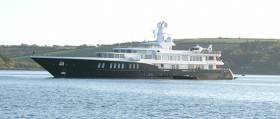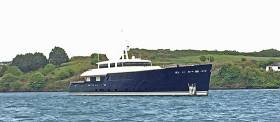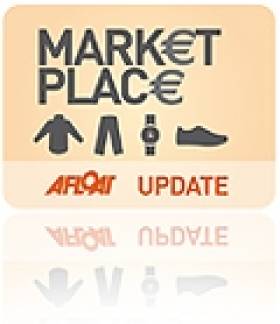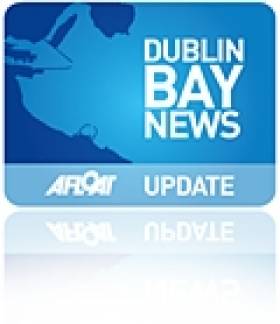Displaying items by tag: Superyacht
Superyacht 'Air' Returns to Cork Harbour
Now regular visitor Superyacht ‘Air’ returned to Cork this morning. The yacht is moored off Cork Harbour anchored off the spit lighthouse in Cobh. This black hulled Dutch-built Feadship was launched in March in 2011 and called to the Irish South coast in 2012 and in 2015. The yacht is available for charter at the reported rate of €750,000 per week. Onboard luxury inlcudes a helicopter pad and 102-inch pop-up movie screen.
If the superyacht follows her usual Irish itinerary then she will move on to Kinsale where she anchors in the mouth of the harbour and tenders in and out. Last year they anchored in the lee of the old head and the onboard helicopter flew from the boat up to the golf course. See our 2015 photos of the superyacht.
Only 24 hours day after the world’s largest privately owned yacht sailed into Cork harbour, a second Superyacht arrived in Kinsale this afternoon.
In an early season boost for the Cork coast, the massive yachts make a fine spectacle in both harbours this evening.
The ‘Galileo G’ is a 55m Perini Navi ice class steel displacement hull built in 2011, British flagged and has accommodation for 10 guests and 12 crew. It is powered by two caterpillar engines with a cruising speed of 11 knots giving it a range of 9,000 nautical miles.

The hull design is from Philippe Briand and the exterior design is from the Vitruvius series
‘It is great to see boats of this calibre now becoming regular visitors to the area', said local yacht broker John McDonald of MGM Boats who welcomed the boat into the town.
Demand for Larger Berths Grow As Marina Visitors Increase
The AGM of the Irish Marina Operators Association (IMOA) took place this month at the end of another successful season. The news from around the coast is that visitor numbers are excellent with Irish marinas attracting large numbers of boats from Britain, France and Norway in particular. Superyachts continue to see Ireland as a new and exciting destination as well as smaller cruising boats from all over the world. Some marinas are filling up again with demand being seen for larger berths in particular. Marina operators are also investing significant sums to upgrade and improve the existing facilities.
On the marketing front, the recent Southampton Boat Show was a success for a number of members who exhibited there. There is an appetite to market Ireland as a marine leisure destination and it is hoped that further marketing in the UK can be carried out.
The topic of dredging was discussed at length and the members aired their frustration at the drawn-out process to receive permission to carry out maintenance works. Similarly it was disappointing to hear that there is still no movement on the Maritime Area and Foreshore (Amendment) Bill 2013. The lack of progress on this front is potentially damaging for the industry as a whole.
Finally, it was agreed by all members that there is a change in the outlook of customers/boat owners and a more positive attitude is evident right around the coast.
Second Super Yacht in a Week Visits Kinsale
#kinsalesuperyacht – Kinsale is a destination of choice for superyachts with a second making a call to the south coast harbour within a week. The 35–metre Vitters built SY 'Ghost' is moored at the Blue flag Kinsale Yacht Club marina this morning and expected to stay until Saturday morning.
The lightweight high performance sailing yacht has a carbon fibre hull and superstructure, the first of its kind for the yard. Her visit follows a return visit from MY 'Air' currently anchored in the shelter of the Old Head, an 81m Feadship.
Superyacht 'Air' Returns to Cork Harbour & Kinsale
#superyachtvisit – Return visitor to Ireland, the 81-metre long super motor yacht 'AIR' cut a dramatic pose as an early season caller to Cork Harbour yesterday. As Afloat reported previously, this black hulled Dutch-built Feadship was launched in March in 2011 and called to the Irish South coast in 2012. The yacht is available for charter at the reported rate of €750,000 per week. Onboard luxury inlcudes a helicopter pad and 102-inch pop-up movie screen.
The largest yacht ever to be built at the Koninklijke De Vries yard, AIR has a sleek and elegant exterior with modern lines, it has a matte black steel hull, and an aluminium superstructure. She measures 265.7 feet in length and has a beam of nearly 39 feet.
Extremely spacious, the vessel can accommodate 12 guests in 7 roomy staterooms including an impressive split level owner's suite, two guest cabins on the upper deck, one cabin on the main deck, and three on the lower deck. The owners' observation lounge offers a breathtaking view over the eight-meter long pool on the main deck's forward area.
$1 Billion For Biggest Ever Superyacht
#Superyacht - Move over, Blush – there's a new contender for the superyacht crown that makes Eddie Jordan's giant look like a tugboat.
Scuttlebutt Sailing News reports on the Triple Deuce, set to be the world's biggest ever superyacht at 222 metres, more than four times larger than the Irish F1 supremo's luxury vessel.
It's also fixing to be the most expensive private yacht ever with an eye-watering $1 billion price tag for the owner, whose identity remains a secret.
But it's the size that matters, as broker Craig Timm explains his client was eager to outdo other superyacht owners such as Roman Abramovich and Sheikh Khalifa bin Zayed Al Nahyan.
Scuttlebutt Sailing News has more on the story HERE.
Luxury Yacht Charter Just A Swipe & Click Away With New Smartphone App
#Superyacht - For those with the cash to splash, chartering a superyacht for a luxury getaway or exclusive party has never been easier thanks to a new smartphone app that makes the process a simple matter of swipe and click.
Mail Online has more on the YPI Selection app from Yachting Partners International - one of the world's biggest yacht brokers - which lists the nearest vessels available to charter, with full details on their specs, including photo galleries.
But perhaps the biggest hook of the app is the ability to book time on board some of the most lavish boats in the world directly from your phone or tablet.
Of course you'll need to be among the "ultra-high net worth individuals" the app is aimed at, with charter rates starting at £25,000 (€31,500) a week, going up to an incredible £750,000 (€946,000).
That's a rate that would make even Eddie Jordan blush, with his so-named 155-foot Sunseeker superyacht available to charter from a relatively modest €200,000 a week.
Eddie Jordan's Superyacht Available To Charter
#Superyacht - Irish F1 supremo Eddie Jordan certainly pulled out all the stops when he caught the yachting bug, commissioning the largest recreational vessel ever built by luxury specialists Sunseeker.
And now his €40-million, 155-foot superyacht Blush, which was launched earlier this year, is available to charter over the winter months.
But as Motor Boat & Yachting reports, you'll need a sizeable bank balance to avail of this offer, as prices start at a whopping €200,000 for just seven days on board the luxury vessel.
More details from Sunseeker on Jordan's mansion-on-the-waves are available to read or download HERE.
Another Superyacht Visits Dublin as 'Arcadia' Berths at Dun Laoghaire Marina
#arcadia – Dun Laoghaire Marina welcomed another superyacht visitor this week when the 35.80m Arcadia berthed at the 800–berth south Dublin Bay facility. Not only does the impressive 'Arcadia' have gorgeous lines but as the 159th vessel to transit the Northwest Passage, she's also a serious long distance expedition motor yacht too.
This luxury vessel's sophisticated exterior design and engineering are the work of Tony Castro Design, the designer of none other than Royal Cork's own 1720 acclaimed sportsboat design. Arcadia was custom built in 2006 by Royal Huisman.
The visit follows June's biggest ever visitor to Dun Laoghaire when the marina said hello to 46m Superyacht Christopher.
Arcadia yacht has an alustar hull with an alustar superstructure with a beam of 8.24m (27'0"ft) and a 2.99m (9'9"ft) draft.
She offers accommodation for up to eight guests and is also capable of carrying up to seven crew onboard to ensure a 'relaxed luxury yacht' experience.
Reports from the Dun Laoghaire watefront say Arcadia owners and crew are having 'a wonderful time' touring the Dun Laoghaire locality, as well as the city centre, and are especially interested in visiting famers markets to sample the best of locally sourced produce.
Say Hello to 46m Superyacht 'Christopher', Dun Laoghaire Marina Welcomes Biggest Ever Visitor
#superyacht – Even seasoned observers are gobsmacked at the sheer size of the 46–metre (150–foot) Superyacht Christopher berthed at Ireland's biggest marina in Dun Laoghaire harbour marina this morning. Dwarfing the 500–local craft moored around it, and at twice the size of the biggest visiting race boats for this Saturday's Round Ireland race, the dark blue hulled Ron Holland Design cruising ketch which has arrived in overnight from Belfast is an impressive sight in the flesh. Now berthed close to the western edge of Dun Laoghaire's five gold anchor marina the superyacht crew are here to 'enjoy all the delights that Dun Laoghaire and Dublin City have to offer'.
Builders Pendennis say the Cayman Islands registered Christopher 'celebrates classic traditions yet embraces new sailing technologies performing equally well as a beautiful family 'home from home' and a performance sailing cruiser'.
The arrival has prompted much speculation about whether Christopher is the largest ever private yacht to visit the east coast port. In a throwback to Victorian times, when Dun Laoghaire was at the centre of yachting devlopment there were a number of very large yachts moored here. For example, in a recent blog by WM Nixon on the subject, the 1865-built schooner Egeria was one of the most successful boats owned by a Royal St George YC member during the halcyon years at the height of the Victorian era, when the club's yacht fleet tonnage was one of the largest in the world. But even Egeria's 100–foot is no match for Christopher.
Innovative technology included twin rudders, a pivoting keel and powerful rig and carbon rigging that provided performance as well as a shallow draft, and infra-red shielding in all windows reducing heat transfer into the accommodation thereby minimizing air con requirements. Her twin balanced rudders are a departure for a large cruising yacht and have been incorporated to maximise sailing performance in strong wind conditions and to allow space for a large Williams Turbojet 505D tender in the lazarette.
The retractable centre board was manufactured using precise CNC systems and when lowered, 'bomb bay' closing doors are deployed to reduce turbulence along the keel bottom.
This is also the first Ron Holland Design Yacht to incorporate all carbon fibre rigging. Another first is the deletion of any mizzen mast jumper strut and stays. This detailing has set a benchmark for improving the sailing performance of large cruising yachts.
The yacht was in Falmouth in the Autumn of 2013 for a winter refit, due to be completed before competing in the 2014 Pendennis Cup. Works include a Lloyd's annual survey; rejuvenating teak cladding and deck; hydraulic system checks and minor interior adjustments.
Pendennis Sailing yacht Christopher Features:
LOA 46m (150.9ft)
Draft 3.8m (12.5ft keel up), 9.4m (31ft keel down)
Beam 9.5m (31.2ft)
Naval Architects Ron Holland Design
Interior Design Ron Holland Design & Pendennis
Owner's Representative Duane MacPhail, Palm Beach Yachts International































































